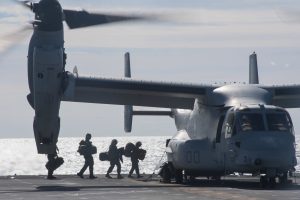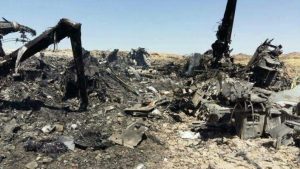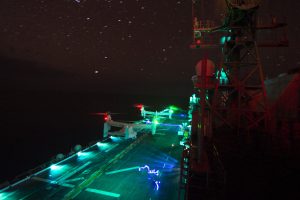 Last week America lost an MV-22 Osprey, a Special Operator and, in addition, had several servicemen injured in a bungled “fishing expedition” in Yemen. What can we learn from this?
Last week America lost an MV-22 Osprey, a Special Operator and, in addition, had several servicemen injured in a bungled “fishing expedition” in Yemen. What can we learn from this?
Details are trickling out, but regardless of their veracity (first reports are often wrong, and there’s always a lot of CYA in this sort of debacle), this raid should, once again, re-emphasize the fact that the MV-22–however sturdy it may be–remains an “operationally fragile” platform, responding poorly to higher-stress, “on-the-fly” missions like casualty evacuation or unit extraction.
The raid should also provide an additional cautionary note to American procurement mavins–that fragile platforms may not do well in an environment where more operational decisions are delegated to lower-level officers. They operate best in a detailed, thorough planning environment.
Followers of this blog know that I consider the MV-22 a less than ideal platform for tricky, possibly contested landing zones (here and some proposed fixes here). It’s a maintenance hog (here), and if the airframe isn’t ready and the crew doesn’t know exactly what they’re doing with their aircraft–blessed with a well characterized and safe landing zone before they fly–the entire mission will be at risk. (But it is, without dispute, a tough airframe)
This tactical brittleness will increasingly be exposed as the White House and DoD presses to allow “lower level” authorization of military activity. The urge to delegate and force lower-ranking officials to accept greater authority offers more flexibility and sometimes gives units more opportunities to move quickly, but if the officers and units aren’t well-trained and prepared, this can backfire. By their nature, lower level approvals mean less consideration for contingencies as well as un-needed compartmentalization (along the lines of old Ace Lyon’s shenanigans in the Gulf back in the eighties) and, well, sooner or later, the Administration and DoD will have a poorly-briefed flight of MV-22s heading into the unknown.
And, as Yemen demonstrated, that’s not good.
The MV-22 is a surgical instrument, procured largely to fit the “high oversight” American way of war–it’s a deliberate, surgical tool, best used at a time of America’s choosing. It’s not (at least not yet) something a commander can just throw into a conflict with little worry. The MV-22 is a platform that works best only if it is allowed to focus on a single, well-thought-out mission at a time. The operational margins on this platform are still neither really well known to the operators, appreciated by commanders, nor understood by policymakers.
Lower-level officers and decision-makers must understand that the MV-22 can only be used with care. Put bluntly, Ospreys like well-selected, non-dusty landing zones where they don’t take fire upon the approach–anything less and that bird will likely come down with a big, hard thud (though, to the platform’s credit, a good number of folks will walk away from hard landings, too). But safe-to-land locations only get found after some good (and rather tedious) advance work (and sophisticated adversaries can also be expected to learn where the preferred MV-22 landing zones are and will treat them accordingly). Those are facts hard-bitten lower-level commanders will likely overlook.
You come in with an MV-22 without doing your homework, and you’ll have a real disaster–like this Yemen debacle almost was.
 What the Heck Happened?
What the Heck Happened?
Like any raid, there’s very little out there, and much of it contradicts the other.
With those caveats in mind, it sounds like the commandos were delivered, possibly by something other than an Osprey, and that the MV-22, operating in a supporting–casualty evacuation or plain old “get the heck out” evacuation–role, had a hard landing. Details are scant, but things went really bad during the raid, the commandos got stuck in, needed an evacuation which led to the “hard” landing, and then the resulting covering fire took out buildings as well as the downed Osprey.
According to the New York Times, in one of the first articles:
A United States military aircraft helping with the operation experienced a “hard landing” near the site of the raid, resulting in injuries to two other service members, military officials said. That aircraft, identified by a senior American official as an Osprey that was evacuating the troops wounded in the firefight, was unable to fly after the landing and was deliberately destroyed by American airstrikes. The wounded troops and the Osprey’s crew were lifted to safety by another American aircraft.
And NBC reported:
“Almost everything went wrong,” the official said.
An MV-22 Osprey experienced a hard landing near the site, injuring several SEALs, one severely. The tilt-rotor aircraft had to be destroyed. A SEAL was killed during the firefight on the ground, as were some noncombatants, including females.
The Washington Post wrote a few days after the attack:
In Saturday’s operation, the SEALs faced difficulties from the start. After the U.S. forces descended on the village of Yaklaa, a heavily guarded al-Qaeda in the Arabian Peninsula (AQAP) stronghold surrounded by land mines, militants launched an intense counterattack.
As the pitched gunbattle continued, officials called in Marine Cobra helicopter gunships, backed by Harrier jets, to strike the AQAP fighters, according to U.S. officials familiar with the incident.
An elite Special Operations air regiment was then sent in to pull the team and its casualties out of the fray, banking into the night under heavy fire to link up with a Marine quick-reaction force that had taken off in MV-22 Ospreys from the USS Makin Island floating offshore.
The two units planned to meet in the desert to transfer the wounded SEALs so they could be taken back to the amphibious assault ship for treatment, but one of the Ospreys lost power, hitting the ground hard enough to wound two service members and disable the aircraft.
The Washington Post report–a weird, poorly-edited kludge of a story–seems to offer some interesting possible operational details. The idea of a casualty transfer in the desert seems a little bit odd. But either the aircraft went down because of sand ingestion from a poorly picked LZ or it got shot up on approach to a hot LZ.
Other nuggets have been released elsewhere–but the general theme is that this raid came within a hair’s breadth of becoming a catastrophe.
 A Rushed Attack
A Rushed Attack
Initial reports suggested that the mission was rushed.
Subsequent reports seem to confirm it was a rushed, ad-hoc approval process that occurred under some pretty substantive political pressure. Reuters says:
U.S. military officials told Reuters that Trump approved his first covert counterterrorism operation without sufficient intelligence, ground support or adequate backup preparations.
As a result, three officials said, the attacking SEAL team found itself dropping onto a reinforced al Qaeda base defended by landmines, snipers, and a larger than expected contingent of heavily armed Islamist extremists.
And the New York Times article–released just as Secretary of Defense Mattis left town–says the approval involved Mattis and came five days into the administration:
With two of his closest advisers, Jared Kushner and Stephen K. Bannon, joining the dinner at the White House along with Defense Secretary Jim Mattis and Gen. Joseph F. Dunford Jr., Mr. Trump approved sending in the Navy’s SEAL Team 6, hoping the raid early last Sunday would scoop up cellphones and laptop computers that could yield valuable clues about one of the world’s most dangerous terrorist groups. Vice President Mike Pence and Michael T. Flynn, the national security adviser, also attended the dinner.
My take is that these guys were either gaming out the political steps to support the furor expected by the immigration ban, and the raid made a nice fit (or vice versa). The fact that a “new moon” was coming on Saturday forced the issue, artificially “pressurizing” the decision-making process and preventing further analysis (It also demonstrates how Mr. Bannon, ever the opportunist, can use his perch in the NSC to align domestic politics with national security events as well.).
As an aside, I also note that the President, when he was supposed to be busy having a dinner decision-making briefing about the raid, was, well, um, tweeting and distracted. The President was very excited about his David Muir interview, tweeting about it at least three times in his 5:05 PM, 7:03 PM, 9:14 PM, 9:45 PM and 9:48 PM EST tweet-storm. But the 9:14 PM tweet suggested something very different. President Trump tweeted, “As your President, I have no higher duty than to protect the lives of the American people”. That suggests to me that the dinner meeting was over, and that the “go” decision was on the President’s mind. (If that’s the case, somebody needs to have a chat with the boss about how hasty twittering telegraphs his intentions.)
But that’s all speculation. I still would like to know more about the decision-making process. The Marines were ready and had trained up in the December 6-22 Exercise Alligator Dagger in Dijbouti. The penultimate exercise was, in retrospect, a dress rehearsal:
Marines and Sailors of the Makin Island Amphibious Ready Group/11th Marine Expeditionary Unit concluded Exercise Alligator Dagger with a nighttime helo-borne raid in Djibouti, Dec. 21, 2016. Launching from the amphibious assault ship USS Makin Island, more than 100 Marines were flown inland via MV-22 Ospreys and CH-53 Super Stallions to conduct a raid on a simulated enemy communications node. Escorted by AH-1Z Cobras, UH-1Y Hueys, and AV-8B Harriers for close-air support, the raid force conducted the mission within a few hours under the cover of darkness.
They probably would have been really ready to rock and roll during the new moon in late December.
Also, I’d like to know more about the high level oversight. The raid was rumbled. Why wasn’t it called off when the SEALs knew they were rumbled? Were lower-level guys scared to “call it” due to the higher-level attention from the White House? Who was actually in command? Again, the NY Times:
Through a communications intercept, the commandos knew that the mission had been somehow compromised, but pressed on toward their target roughly five miles from where they had been flown into the area. “They kind of knew they were screwed from the beginning,” one former SEAL Team 6 official said.
Consider the pressure they were under to forge ahead. It had to have been substantial–for a junior officer to make this call would have been career killing. Keep in mind, this was happening as the White House was desperately looking for something–anything–to deflect from the national furor over their sloppily-implemented Immigration ban. The President–despite denials-was likely watching.
Despite news of Secretary Mattis’ engagement in the plan, I do wonder if he was fully in the loop. If sunrise in Yemen is at 6:30 AM–which, to me, suggests that you’re loosing cover by 5:30 AM (9:30 PM Washington time), and if Secretary Mattis–as reports suggest–was pulled from the Alfalfa Club dinner at about that time, then…I certainly don’t sense that Secretary Mattis is a micromanager, but I have a hard time believing he is the kind of guy who would attend a high-society dinner while his troops are embarking upon the first “high profile” mission of the Administration. Something doesn’t quite fit. It might have been good to have a former field operator around in the room to make the call when the SEALs knew they’d lost the element of surprise. Ultimately, his decision to attend the Alfalfa Dinner diminished him.
 What Does This Mean For Gear:
What Does This Mean For Gear:
Politics aside, if the White House is going to be pressing the decision-making down to the lowest possible level–and prioritizing speed and improvisation over a more deliberately-paced (and yes, often annoying and options-limiting) interagency/Joint process, we cannot purchase platforms that are operationally fragile.
After years of operating at the end of a very controlling NSC, field-grade people will use their authority to do stupid things (irrational exuberance is a thing!). Junior folks will likely be asked to do stupid things and pressed by White House influencers outside of the chain of command to do stupid things. It’s human nature.
Ultimately, this new authority gives folks a chance to get in trouble. Trouble will come, and then higher headquarters will need to haphazardly throw everything but the kitchen sink into battle to, oh, save some over-adventurous Lt General’s career.
And that’s where things could go from bad to worse in a hurry.
To compensate for that emergent risk, America must focus on procuring–at least for the front line–items that are operationally mature. If America is going to be focused on lower-level authority, then those warriors need stuff that can take the rough-and-tumble and be able to be employed in situations that aren’t fully analyzed.
The Osprey is a case in point. It’s robust (I’m amazed at how many people walk away from “hard landings”) but it is still too darn fragile (and yes, I’m also amazed at how many of these aircraft essentially “belly flop”). Ideally, the Marines would have procured something a little more ready for combat, but, well, that’s water under the bridge. To help fix the situation, the Pentagon should consider a few things:
More robust training: While stateside, MV-22 airframes are too often tied to nicely groomed landing zones that are picked precisely to NOT stress the aircraft and operator. Look at the LZs for Camp Pendleton–they’re not quite “groomed” tennis courts, they’re pretty damn close. Operators need to be put into stressful situations where they are not landing on perfectly-groomed ground. It raises the risk of training mishap, but realistic training lowers the risk of a far more catastrophic accident in the field. It lets users learn the operational parameters of their equipment–and that’s how pilots learn to properly use their airframe to respond to desperate calls for, say, an evacuation of a dying SEAL.
Don’t Inflate Readiness Rates: If you don’t have time to do the maintenance right, don’t let it fly–and don’t let anybody pressure you to fly unready airframes.
Keep MV-22s Out of Sand and Fire: You’d think America would know enough now to not land this thing in ill-advised places. MV-22s don’t respond well to fire, sand and stress.
Outside of the MV-22, America must recognize that the Officer Corps has operated in an NSC-dominated planning cycle for almost ten years. It will take time and training to grow beyond this. Here’s some suggestions:
Reach Out: If you’re an operational commander, it will be on you to reach out to insure your own success. While there won’t be an NSC intruding into your operational business (Yay!), there won’t be an intrusive NSC working to ensure that you’ll have thoroughly coordinated backup and contingency plans, either (Boo!). Planning will be upon you–and contingency questions will need to be brought up at a lower level than ever–for example, it’ll be up to commanders to ensure that they use the MV-22 in the most effective fashion. And they’ll need to do this in an atmosphere where information sharing will be far more difficult than in the past. Always pulse that chain of command and make sure everybody is read in who can be. Don’t be dragged into something by somebody sidestepping the Chain of Command.
REALLY enable Lower-Level Officers: If lower-level officers are honestly given the authority to “make the call” on operations, they should also be allowed to call them off if the tactical conditions aren’t right. You can’t give folks in the field authority only to refuse it when the time comes to go “over the top”. Even if the President is watching AND that President needs a quick political boost from a neatly-timed raid, the correct tactical decision MUST be allowed to be made, and the guy to make it is often the guy in tactical command. Don’t let that call be a career-killer. That’s hard–World War II sub patrol evaluations taught us all that timidity is not something to reward. But, conversely, officers must be trained to avoid overconfidence and arrogance.
Good luck out there. There will be stumbles ahead, and there will be some challenges getting brittle gear aligned to suit a more flexible, fleet-of-foot force. But it is the right way to go.
